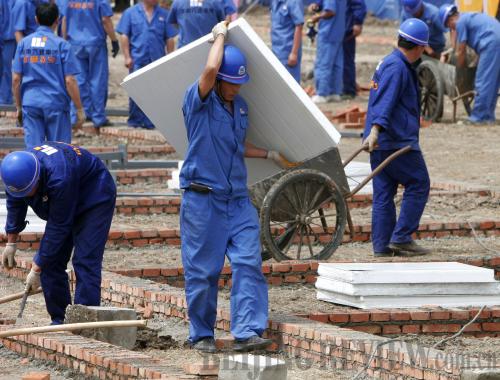|
 |
|
SWEAT SOAKING: Workers from Luoyang, Henan Province, construct temporary buildings in quake-hit regions in Sichuan Province, on May 28, 2008 (XINHUA) |
A 30-minute ride from Hongbai is Mianzhu City, which now features an architectural style similar to Suzhou, a garden city in east China's Jiangsu Province. The eastern city is famed for its delicately designed houses, bridges and gardens. Suzhou, along with Hangzhou in Zhejiang Province, has been praised as a paradise on Earth.
Reconstruction workers from Suzhou working in Mianzhu are adamant about their role in rebuilding the city. "We won't go back home until Mianzhu looks as wonderful as Suzhou" is a proud declaration among many of the aid workers from the east China city. In the past three years, a team of 200 designers and 5,000 workers from 20 construction groups finished 103 projects with a combined investment of 2.8 billion yuan ($432.12 million) in Mianzhu.
In Mianzhu and beyond, aid workers fought the clock to provide a speedy recovery to the region and its people. Their efforts are paying off as local residents boast about the beauty of the houses, the safety of the schools and the state-of-the-art hospitals.
Sustainable growth
The nationwide countrywide partnerships don't just extend to rebuilding cities and towns. It also includes revitalizing economies from the local to provincial level.
"Besides giving us a completely new, modern town, aid workers from Shandong Province are showing us new economic and social development paths," Han Guijin, Deputy Director of Reconstruction Project of Beichuan County, told Beijing Review.
Beichuan was one of the worst areas to bear the brunt of the earthquake. In a mere 90 seconds, thousands of residents in the town perished. Almost every family in the town suffered casualties. The flattened town (See page 22) now functions as a memorial site. A new town for Beichuan survivors, called Yongchang, which means eternal prosperity, now stands 20 km away.
Starting in June 2009, more than 30,000 aid workers from Shandong rolled up their sleeves, devoted to the 64 projects in Yongchang. A total of 4.6 billion yuan ($709.92 million) from Shandong poured into the new town, and in September 2010, a 5-square-km town, expected to be home to 35,000 people, was ready for Beichuan residents.
In addition, 24 enterprises, with a total investment of 1.6 billion yuan ($246.94 million) from Shandong, started operating in the 1.4-square-km Beichuan-Shandong Industrial Park. More than 1,000 manufacturing jobs were initially created. An agricultural park with a total investment of 180 million yuan ($27.73 million) is under construction and will provide more than 10,000 jobs. Experts from Shouguang in Shandong, one of China's largest vegetable trading hubs, are helping build a vegetable base in the park.
The situation in nearby new towns is also promising. Newly finished Jiangsu Industrial Park in Mianzhu and Wuxi Industrial Park in the city's Hanwang Town cover around 10 square km. More than 20 hi-tech enterprises have settled in and are looking for employees. They have the ambition to build themselves into provincial-level industrial parks each with an annual output value of 50 billion yuan ($7.72 billion) in five years.
Not far away in Hanwang, the traditional New Year's painting industry flourishes after taking advantage of the partnership. Suzhou spent more than 30 million yuan ($4.62 million) and established a New Year's painting base in Nianhua Village, a new village combining two former villages. Now more than 90 percent of the villagers make a living on making New Year's paintings, as well as related businesses in the process. Jiangsu has also helped with sales of the paintings.
"We have a new house, and a new life," Wei Daxiang, a 62-year-old villager from Nianhua Village, told Beijing Review. Her two sons and daughters-in-law are either employed in the Jiangsu Industrial Park or engaged in painting-related businesses.
Tradition reawakening
Mianzhu is one of the four famous manufacturers of New Year's paintings in China, along with Yangliuqing in Tianjin, Taohuawu in Jiangsu and Weifang in Shandong. It features bright colors and intricate hand painting, a style dating back to the Song Dynasty (960-1279) and thrived in the Qing Dynasty (1644-1911) but fell to the wayside in recent decades. Young people have been reluctant to learn the skills required to master the handicraft. Since the reconstruction began, the art form, which is protected as an intangible cultural heritage, has been saved from the brink of extinction.
Thirty-year-old Chen Gang is one of the inheritors of the Mianzhu New Year's painting craft. He is learning from his 92-year-old grandfather and will teach his 4-year-old son. More than 100,000 yuan ($15,400) can be made annually from the business, Chen told Beijing Review.
| 